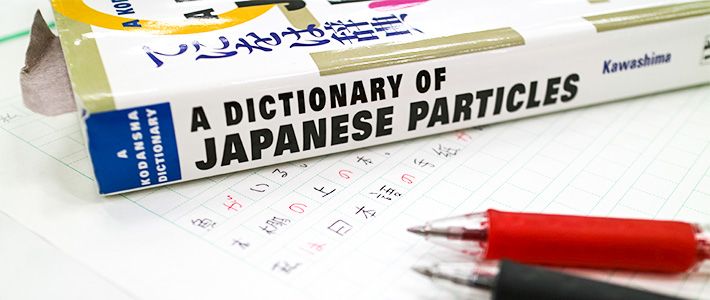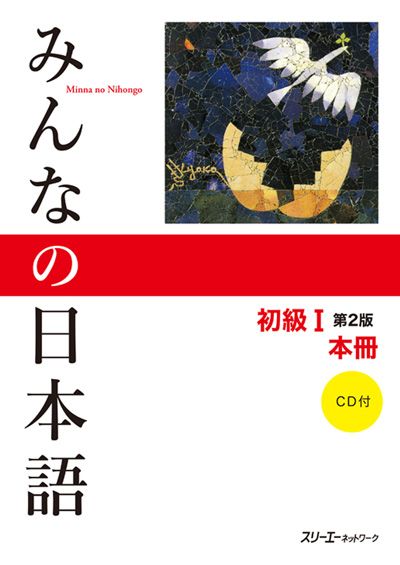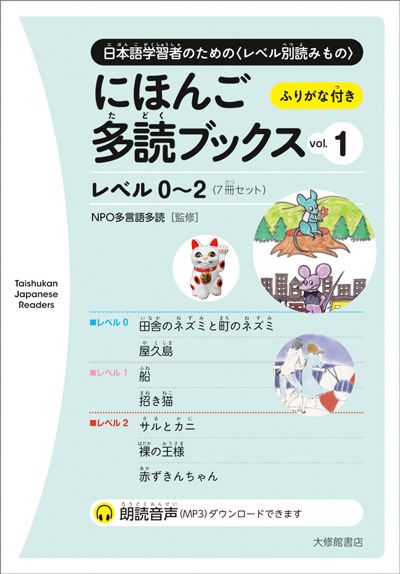
Books for Studying Japanese
Culture
These courses, reference works, and workbooks offer assistance on the journey to Japanese proficiency.
- English
- 日本語
- 简体字
- 繁體字
- Français
- Español
- العربية
- Русский
The reference works described below may come in handy for learners of Japanese looking to learn more kanji, polish their grammar, or prepare for a test. We’ll be updating the list from time to time, so if there’s a book you think belongs in one of these categories, leave a comment and let us know!  This series sets out the basics of Japanese in a simple, logical format, taking students through elementary and intermediate levels. Because it is written entirely in Japanese, it is commonly used at language schools; accompanying books with translation and grammatical notes are sold separately and are available in many languages. Workbooks are also available for extra practice.
This series sets out the basics of Japanese in a simple, logical format, taking students through elementary and intermediate levels. Because it is written entirely in Japanese, it is commonly used at language schools; accompanying books with translation and grammatical notes are sold separately and are available in many languages. Workbooks are also available for extra practice.  The Japanese Language Proficiency Test is the best-known measure of ability in Japanese, and this series focuses squarely on helping readers pass each level, from N4 to the hardest N1 test. There are different books for the various parts of the test and the necessary skills, such as grammar, listening, reading, kanji, and vocabulary. The information is well organized and comprehensive, making the series a natural choice for students with their sights set on acquiring JLPT certificates.
The Japanese Language Proficiency Test is the best-known measure of ability in Japanese, and this series focuses squarely on helping readers pass each level, from N4 to the hardest N1 test. There are different books for the various parts of the test and the necessary skills, such as grammar, listening, reading, kanji, and vocabulary. The information is well organized and comprehensive, making the series a natural choice for students with their sights set on acquiring JLPT certificates.  This is the standard reference for getting to grips with Japanese grammar. After a general overview of topics like word order and politeness, the book provides clear and detailed English explanations on the full gamut of grammar points. Although the title says it is “basic,” it will prove a valuable reference at higher levels too—although there are also intermediate and advanced books in the series for students ready for more.
This is the standard reference for getting to grips with Japanese grammar. After a general overview of topics like word order and politeness, the book provides clear and detailed English explanations on the full gamut of grammar points. Although the title says it is “basic,” it will prove a valuable reference at higher levels too—although there are also intermediate and advanced books in the series for students ready for more.  Try this reference work to zoom in on the tricky area of particles. From the vexing question of ga versus wa to combinations like ni mo and ni oite, there are in-depth explanations of each point. Example sentences are given in kanji/kana, rōmaji, and English, but the author notes that the meaning of particles can often only be approximated in translation.
Try this reference work to zoom in on the tricky area of particles. From the vexing question of ga versus wa to combinations like ni mo and ni oite, there are in-depth explanations of each point. Example sentences are given in kanji/kana, rōmaji, and English, but the author notes that the meaning of particles can often only be approximated in translation.  The Japan Kanji Aptitude Test is a popular test of character knowledge. The test covers a wide range of proficiency from grade 10—the lowest, requiring the ability to read and write 80 kanji—to grade 1, for which candidates must master 6,000 characters. The test is open to anyone, but mainly Japanese people take it, so these official books are aimed at native learners. As a result, one of their attractions is a rich corpus of graded example sentences in natural Japanese—often absent from English-language kanji materials. Learning kanji in context through different approaches makes them easier to remember. The official books go up to grade 2 (requiring more than 2,000 kanji).
The Japan Kanji Aptitude Test is a popular test of character knowledge. The test covers a wide range of proficiency from grade 10—the lowest, requiring the ability to read and write 80 kanji—to grade 1, for which candidates must master 6,000 characters. The test is open to anyone, but mainly Japanese people take it, so these official books are aimed at native learners. As a result, one of their attractions is a rich corpus of graded example sentences in natural Japanese—often absent from English-language kanji materials. Learning kanji in context through different approaches makes them easier to remember. The official books go up to grade 2 (requiring more than 2,000 kanji).  Reading is a key skill for building language ability, but it can be hard to know where to start. These packs of books are graded to different reading levels by grammar and vocabulary, so students can choose the appropriate degree of difficulty. Lively illustrations are an aid to understanding, and the titles include everything from simplified versions of Japanese fairytales to literary classics.
Reading is a key skill for building language ability, but it can be hard to know where to start. These packs of books are graded to different reading levels by grammar and vocabulary, so students can choose the appropriate degree of difficulty. Lively illustrations are an aid to understanding, and the titles include everything from simplified versions of Japanese fairytales to literary classics.  Aspiring and early-career translators will benefit from this volume, which is suitable for advanced Japanese students. It encourages readers to consider different approaches to translation and includes many exercises with model answers. It also highlights specific differences between Japanese and English, along with their implications for translation. For example, tenses do not always match neatly, so it may not be suitable to translate a “present-tense” Japanese phrase into the present tense in English.
Aspiring and early-career translators will benefit from this volume, which is suitable for advanced Japanese students. It encourages readers to consider different approaches to translation and includes many exercises with model answers. It also highlights specific differences between Japanese and English, along with their implications for translation. For example, tenses do not always match neatly, so it may not be suitable to translate a “present-tense” Japanese phrase into the present tense in English.
For General Language Study
Minna no Nihongo (Japanese Learning for Everybody) (3A Corporation)
 This series sets out the basics of Japanese in a simple, logical format, taking students through elementary and intermediate levels. Because it is written entirely in Japanese, it is commonly used at language schools; accompanying books with translation and grammatical notes are sold separately and are available in many languages. Workbooks are also available for extra practice.
This series sets out the basics of Japanese in a simple, logical format, taking students through elementary and intermediate levels. Because it is written entirely in Japanese, it is commonly used at language schools; accompanying books with translation and grammatical notes are sold separately and are available in many languages. Workbooks are also available for extra practice. Also Consider:
While some students benefit from the total immersion in Japanese, others may find it tough going, particularly if they are studying on their own. If you think you might prefer more support in English, have a look at the series below. Tastes vary, but Genki seems to be the most popular of these.- Genki (The Japan Times)
- Japanese for Busy People (Association for Japanese-Language Teaching)
- Japanese from Zero! (George Trombley and Takenaka Yukari, YesJapan)
Preparing for the Japanese Language Proficiency Test
Shin kanzen masutā (New Complete Master Nihongo Noryoku Shiken Series: The Japanese Language Proficiency Test) (3A Corporation)
 The Japanese Language Proficiency Test is the best-known measure of ability in Japanese, and this series focuses squarely on helping readers pass each level, from N4 to the hardest N1 test. There are different books for the various parts of the test and the necessary skills, such as grammar, listening, reading, kanji, and vocabulary. The information is well organized and comprehensive, making the series a natural choice for students with their sights set on acquiring JLPT certificates.
The Japanese Language Proficiency Test is the best-known measure of ability in Japanese, and this series focuses squarely on helping readers pass each level, from N4 to the hardest N1 test. There are different books for the various parts of the test and the necessary skills, such as grammar, listening, reading, kanji, and vocabulary. The information is well organized and comprehensive, making the series a natural choice for students with their sights set on acquiring JLPT certificates. Also Consider:
- Nihongo sōmatome (Japanese General Summary) (Ask)
Polishing Your Grasp of Grammar
A Dictionary of Basic Japanese Grammar (Makino Seiichi and Tsutsui Michio, Japan Times)
 This is the standard reference for getting to grips with Japanese grammar. After a general overview of topics like word order and politeness, the book provides clear and detailed English explanations on the full gamut of grammar points. Although the title says it is “basic,” it will prove a valuable reference at higher levels too—although there are also intermediate and advanced books in the series for students ready for more.
This is the standard reference for getting to grips with Japanese grammar. After a general overview of topics like word order and politeness, the book provides clear and detailed English explanations on the full gamut of grammar points. Although the title says it is “basic,” it will prove a valuable reference at higher levels too—although there are also intermediate and advanced books in the series for students ready for more. A Dictionary of Japanese Particles (Sue A. Kawashima, Kōdansha)
 Try this reference work to zoom in on the tricky area of particles. From the vexing question of ga versus wa to combinations like ni mo and ni oite, there are in-depth explanations of each point. Example sentences are given in kanji/kana, rōmaji, and English, but the author notes that the meaning of particles can often only be approximated in translation.
Try this reference work to zoom in on the tricky area of particles. From the vexing question of ga versus wa to combinations like ni mo and ni oite, there are in-depth explanations of each point. Example sentences are given in kanji/kana, rōmaji, and English, but the author notes that the meaning of particles can often only be approximated in translation. Also Consider:
- Nihongo bunkei jiten (Dictionary of Japanese Sentence Patterns) (Kuroshio)
Kanji Learning Guides
Kanken kanji gakushū steppu (Kanji Kentei Kanji Study Steps) (Japan Kanji Aptitude Testing Foundation)
 The Japan Kanji Aptitude Test is a popular test of character knowledge. The test covers a wide range of proficiency from grade 10—the lowest, requiring the ability to read and write 80 kanji—to grade 1, for which candidates must master 6,000 characters. The test is open to anyone, but mainly Japanese people take it, so these official books are aimed at native learners. As a result, one of their attractions is a rich corpus of graded example sentences in natural Japanese—often absent from English-language kanji materials. Learning kanji in context through different approaches makes them easier to remember. The official books go up to grade 2 (requiring more than 2,000 kanji).
The Japan Kanji Aptitude Test is a popular test of character knowledge. The test covers a wide range of proficiency from grade 10—the lowest, requiring the ability to read and write 80 kanji—to grade 1, for which candidates must master 6,000 characters. The test is open to anyone, but mainly Japanese people take it, so these official books are aimed at native learners. As a result, one of their attractions is a rich corpus of graded example sentences in natural Japanese—often absent from English-language kanji materials. Learning kanji in context through different approaches makes them easier to remember. The official books go up to grade 2 (requiring more than 2,000 kanji). Also Consider:
- Remembering the Kanji (James W. Heisig, University of Hawaii Press)
Pick Up the Reading Habit
Taishūkan Japanese Readers (Taishūkan)
 Reading is a key skill for building language ability, but it can be hard to know where to start. These packs of books are graded to different reading levels by grammar and vocabulary, so students can choose the appropriate degree of difficulty. Lively illustrations are an aid to understanding, and the titles include everything from simplified versions of Japanese fairytales to literary classics.
Reading is a key skill for building language ability, but it can be hard to know where to start. These packs of books are graded to different reading levels by grammar and vocabulary, so students can choose the appropriate degree of difficulty. Lively illustrations are an aid to understanding, and the titles include everything from simplified versions of Japanese fairytales to literary classics. The Translation Challenge
The Routledge Course in Japanese Translation (Hasegawa Yōko, Routledge)
 Aspiring and early-career translators will benefit from this volume, which is suitable for advanced Japanese students. It encourages readers to consider different approaches to translation and includes many exercises with model answers. It also highlights specific differences between Japanese and English, along with their implications for translation. For example, tenses do not always match neatly, so it may not be suitable to translate a “present-tense” Japanese phrase into the present tense in English.
Aspiring and early-career translators will benefit from this volume, which is suitable for advanced Japanese students. It encourages readers to consider different approaches to translation and includes many exercises with model answers. It also highlights specific differences between Japanese and English, along with their implications for translation. For example, tenses do not always match neatly, so it may not be suitable to translate a “present-tense” Japanese phrase into the present tense in English. (Originally published in English.)